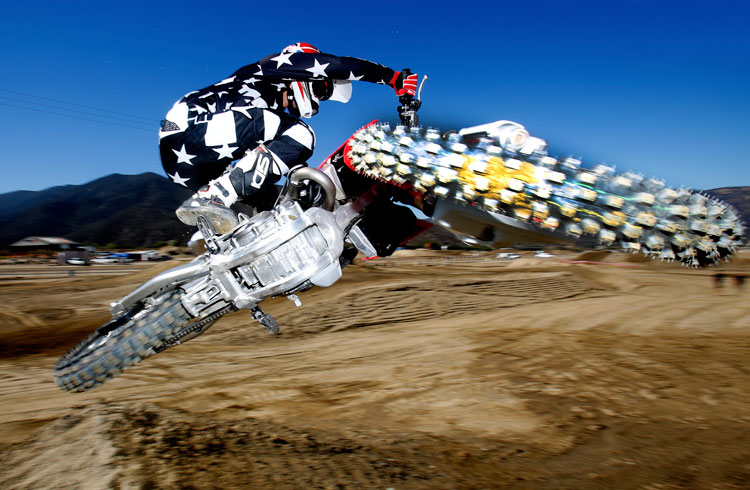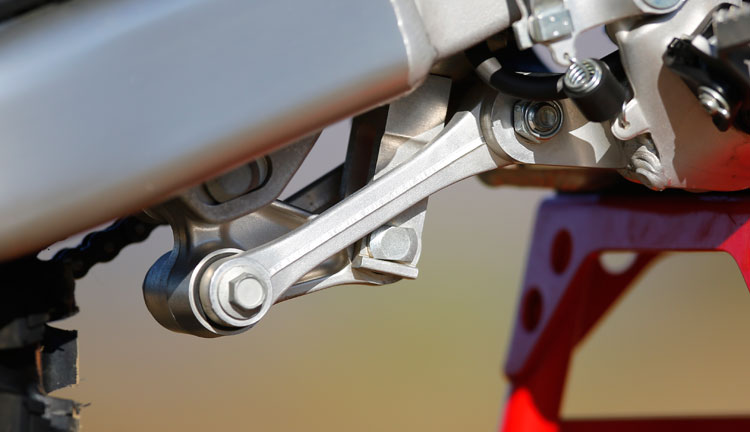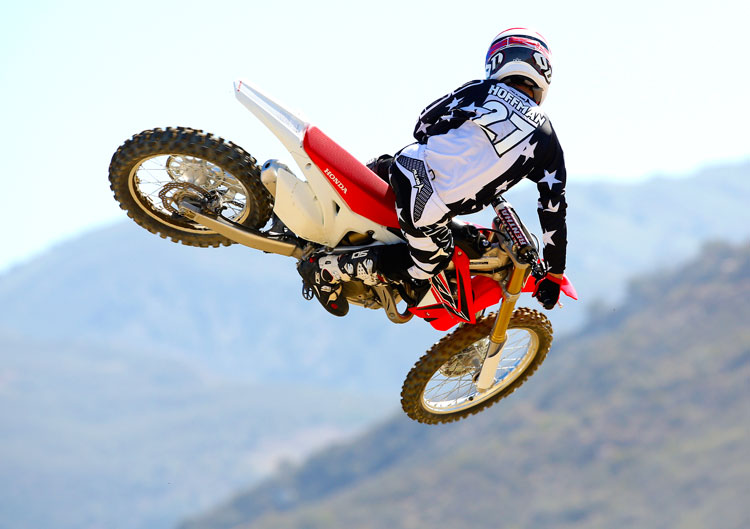Story: By Scott Hoffman and Dustin Hoffman (No Relation)
Photos: Scott Hoffman

With a very short list of changes heading into the coming new year, Honda unveiled their 2016 CRF450R. Although we always keep an open mind when testing new models (because we get to ride brand new motorcycles), initially we weren’t expecting much between the 15’ and 16’. Ironically, this intro was also just a few days after photos of a prototype possible future CRF450R started to pop up on the web.
“Ironically, all three riders came back from their first ride on the 16 noting that stock vs. stock, the 16’ is a noticeable improvement over the 15”
 For 2016, Honda made a handful of revisions to improve the CRFs handling, stability and balance of the motorcycle. First they lengthened the front fork 5mm, raising the front of the chassis. Second they altered the rear linkage ratio to improve feel and improve traction. The new link is actually taken from the CRF250R. The link is slightly more firm initially yet is more linier with less of a spike toward the end of the stroke. Note the fork and shock valving have also been altered slightly to accommodate the new balance of the chassis and link ratio. The chain roller has been decreased in size from 38mm to 34mm. Honda said this is a mod that was taken from the racing division and allows the wheel to travel further into the stroke before the chain makes contact with the roller, this mod is said to help with traction.
For 2016, Honda made a handful of revisions to improve the CRFs handling, stability and balance of the motorcycle. First they lengthened the front fork 5mm, raising the front of the chassis. Second they altered the rear linkage ratio to improve feel and improve traction. The new link is actually taken from the CRF250R. The link is slightly more firm initially yet is more linier with less of a spike toward the end of the stroke. Note the fork and shock valving have also been altered slightly to accommodate the new balance of the chassis and link ratio. The chain roller has been decreased in size from 38mm to 34mm. Honda said this is a mod that was taken from the racing division and allows the wheel to travel further into the stroke before the chain makes contact with the roller, this mod is said to help with traction.
The engine is the same as the 2015 except a few Honda techs noted there is a part number change with the left side exhaust, yet they don’t believe there was any intended performance advantage to the change. Although others have touted that the CRF450R has been underpowered for the past few years, we have always praised the manageable power output, especially on rough tracks and toward the end of the day. Yes a little more torque and overrev would be nice but the bike is still fast and has ample power for the average skill level rider. When we see average riders twist a 450 to the stops from corner to corner, then we might agree you are in need of more, but until that day—you know what to do. Although the CRF450F offers up three different ignition map settings via a handlebar switch, standard, mellow and aggressive, we rode with the standard map for the lions share of the test. The standard map seemed to work best at Pala since the track had a semi-firm base with loose topsoil.

DBT had three riders take a stab at the new Honda: a fast pro from the current scrub generation who weights in at the 160 pound range, an amateur rider (@ 185lbs) who currently owns a 2015 CRF450R and a washed up vet rider who, at 216lbs., weights outside Honda’s target audience.
 Test Rider Dustin Hoffman had no trouble tossing the 2016 CRF450R around like a rag doll.
Test Rider Dustin Hoffman had no trouble tossing the 2016 CRF450R around like a rag doll.
Ironically, all three riders came back from their first ride on the 16 noting that stock vs. stock, the 16’ is a noticeable improvement over the 15, even with the minimal changes. Yes the old guy had to catch his breath before talking but the feedback was the same.
It seems Honda often builds the best bike at the end a specific model generation. The 2008 CRF, (2005-2008 era) even to this day, is praised by some and the 2012 (2009-2012) was by far the most refined bike of that generation. And now the 16 (which may or may not be the end of this model) seems to have made another stride forward compared to a stock 2013-2015. Should you desire more power, an aftermarket exhaust, some EFI/timing changes and an air box mod might do the trick.
OK, back to the stock 16. The chassis is more balanced and tracks very well with the changes. The idea was to take away that slight stinkbug feeling some riders have talked about and also make the entire chassis more stable. The rear end is what is most impressive on the 16 CRF. The revision keeps the rear wheel tracking very well and helps place more of the bike’s power to the ground. It sounds odd, but every test rider felt the 16 CRF was faster than the 15. Honda swears the engine and FI mapping are the same. After a day of testing we realized the reason the bike feels faster is because the rear wheel is more planted which has drastically improved traction. The rear hooks up better and that sensation translates to a faster feeling and probably slightly faster motorcycle. Setting up the shock was pretty easy, 103mm of sag is about the rage but we worked around depending on rider preference. The shock spring was too soft for our heavy rider to set up properly and we will have to test stiffer springs down the line when we get the bike for a long-term test.

To some, the chassis changes were not specific to one pinpoint, it just revised the entire chasses and allowed the bike to be ridden more aggressively by the pro and added a ring of comfort and confidence to the amateur riders. Again we give most of the credit to the rear shock and rear of the motorcycle.
 The 2016 CRF450R has a new rear link that is actually taken directly from the CRF250R.
The 2016 CRF450R has a new rear link that is actually taken directly from the CRF250R.
Up front the fork is the same PS2 unit from 2015, yet longer. 5mm is not a lot but the combo with the rear link made for a more stable chassis even in the chop, under acceleration and while braking. The fork valving changes did improve the action but all three of our riders spent the most of their testing dialing in the fork. The faster pro rider was trying to improve feel and traction while the amateur riders were trying to improve small bump harshness and tune in more front wheel tracking through bumps better. We all made strides forward, yet we all left for the day with a few unanswered questions and the need for more testing. It could have been the track conditions of the day and or the tire selection that left unanswered questions with regard to the fork, or it could just be the fork. Later we plan on testing more settings, going to different tracks and trying a few different front tires. In the past we have preferred the Dunlop MX32 because we feel the tire is more forgiving in small chop. The Honda comes stock with Dunlop MX52 tires front and rear. The fork was the one piece that we left the test day without being able to find the perfect setup
The heavier rider went up on air pressure one pound from 35 to 36psi, and out a few clicks on compression, which helped some on small bump compliance, The faster rider tuned both high and low speed rebound and compression to achieve a better feel to the front and achieve more feel, grip and feedback in certain parts of the track. It often seemed as if when we fixed the fork in one area of the track, it created a different feeling in another portion of the track. Finding a balance will require more testing.
It’s impossible to solve the world’s problems in one day and it is not easy to give you specific irrefutable intelligence and feedback on a bike after riding it for only one day at one specific track. We can tell you the 2016 CRF450R is a better mousetrap. The changes are subtle yet add up in the end. The chassis is more stable, the bike feels faster because the rear end is vastly improved with added traction and stability. The bike is still light and flickable and the fork is better but we reserve the right to make specific judgment until we have more time on the bike. The engine is not as fast as the KX450F or the KTM, but it is easy to ride and we often feel that unless you are amazing with regard to throttle control, the CRF is the everyman’s engine, maybe not always as exciting, but easier to ride.
DBT will have a detailed test on the bike once we get our paws on a long term bike that we can flog at a variety of tracks and conditions, stay tuned.




2 Responses to “First Ride: 2016 Honda CRF450R”
Mike Patrick
The old YOU DONT NEED MORE POWER unfortunately isn’t true and doesn’t hold water. Do you get better results at the end of the day by pulling the holeshot or by being dead last into the first turn? — In a drag race from corner to corner if you are faster than the other guy, you win. If you have more power to roll it on through the turns, you are going faster… nobody not even Dungey, Villopoto, Barcia can use all the power that any bike makes or they wouldn’t have a throttle. You would just kick start it and when the gate drops push a button and it would be wide open for 30 minutes plus 2 laps. Doesn’t work that way though. So more “USABLE” power is always welcome(d). ~ Mikeee P
Scott Hoffman
I disagree: Average riders and most older riders tend to go faster longer on a bike that has more controlled and smoother power. Yes faster bikes get to the first turn faster on average but unless you are in amazing shape, a fast hard-hitting bike will wear you out faster and lap times will drop more rapidly. The times an average rider has a 450 to the stops for an extended amount of time is not as much as one would think. Average riders are only using a fraction of the power exiting turns so a super-fast hard hitting bike not an advantage for most. If you are Dungey, Villopoto or a guy like Barcia, yes you need a fast bike at that level, but what, we are probably talking about less than 1% of riders are at that level. There was a time not too long ago that a 50hp 450 was a rocket ship. Yes the Honda could use a tad more ramp into the mid range and a little more over-rev. There is line between a slow and a fast 450, the CRF is not slow but does not put out as much HP as the others, but very rider friendly and competitive for the “Average” rider.